Analysis of DC Characteristics in GaN-Based Metal-Insulator-Semiconductor High Electron Mobility Transistor with Variation of Gate Dielectric Layer Composition by Considering Self-Heating Effect
Abstract
1. Introduction
2. Materials and Methods
3. Results and Discussion
4. Conclusions
Author Contributions
Funding
Conflicts of Interest
References
- Mishra, U.K.; Parikh, P.; Wu, Y.F. AlGaN/GaN HEMTs-an overview of device operation and applications. Proc. IEEE 2002, 90, 1022–1031. [Google Scholar] [CrossRef]
- Mishra, U.K.; Shen, L.; Kazior, T.E.; Wu, Y.F. GaN-based RF power devices and amplifiers. Proc. IEEE 2008, 96, 287–305. [Google Scholar] [CrossRef]
- Ambacher, O.; Foutz, B.; Smart, J.; Shealy, J.R.; Weimann, N.G.; Chu, K.; Murphy, M.; Sierakowski, A.J.; Schaff, W.J.; Eastman, L.F.; et al. Two dimensional electron gases induced by spontaneous and piezoelectric polarization in undoped and doped AlGaN/GaN heterostructures. J. Appl. Phys. 2000, 87, 334–344. [Google Scholar] [CrossRef]
- Chung, J.W.; Roberts, J.C.; Piner, E.L.; Palacios, T. Effect of gate leakage in the subthreshold characteristics of AlGaN/GaN HEMTs. IEEE Electron Device Lett. 2008, 29, 1196–1198. [Google Scholar] [CrossRef]
- Kim, H.; Lee, J.; Liu, D.; Lu, W. Gate current leakage and breakdown mechanism in unpassivated AlGaN/GaN high electron mobility transistors by post-gate annealing. Appl. Phys. Lett. 2005, 86, 143505. [Google Scholar] [CrossRef]
- Park, Y.J.; Kwak, H.T.; Chang, S.B.; Kim, H.S. Breakdown Voltage Enhancement in AlGaN/GaN High-Electron Mobility Transistor by Optimizing Gate Field-Plate Structure. J. Nanosci. Nanotechnol. 2019, 19, 2298–2301. [Google Scholar] [CrossRef] [PubMed]
- Arulkumaran, S.; Egawa, T.; Ishikawa, H.; Jimbo, T. Temperature dependence of gate–leakage current in AlGaN/GaN high-electron-mobility transistors. Appl. Phys. Lett. 2003, 82, 3110–3112. [Google Scholar] [CrossRef]
- Yan, D.; Lu, H.; Cao, D.; Chen, D.; Zhang, R.; Zheng, Y. On the reverse gate leakage current of AlGaN/GaN high electron mobility transistors. Appl. Phys. Lett. 2010, 97, 153503. [Google Scholar] [CrossRef]
- Wang, A.; Zeng, L.; Wang, W. Simulation of Gate Leakage Current of AlGaN/GaN HEMTs: Effects of the Gate Edges and Self-Heating. ECS J. Solid State Sci. Technol. 2017, 6, 3025–3029. [Google Scholar] [CrossRef]
- Kwak, H.T.; Chang, S.B.; Kim, H.J.; Jang, K.W.; Yoon, H.; Lee, S.H.; Lim, J.W.; Kim, H.S. Operational Improvement of AlGaN/GaN High Electron Mobility Transistor by an Inner Field-Plate Structure. Appl. Sci. 2018, 8, 974. [Google Scholar] [CrossRef]
- Ye, G.; Wang, H.; Arulkumaran, S.; Ng, G.I.; Hofstetter, R.; Li, Y.; Anand, M.J.; Ang, K.S.; Maung, Y.K.Y.; Foo, S.C. Atomic layer deposition of ZrO2 as gate dielectrics for AlGaN/GaN metal-insulator-semiconductor high electron mobility transistors on silicon. Appl. Phys. Lett. 2013, 103, 142109. [Google Scholar] [CrossRef]
- Zhu, J.J.; Ma, X.H.; Xie, Y.; Hou, B.; Chen, W.W.; Zhang, J.C.; Hao, Y. Improved interface and transport properties of AlGaN/GaN MIS-HEMTs with PEALD-grown AlN gate dielectric. IEEE Trans. Electron Devices 2014, 62, 512–518. [Google Scholar]
- Chou, P.C.; Chen, S.H.; Hsieh, T.E.; Cheng, S.; Del Alamo, J.; Chang, E. Evaluation and reliability assessment of GaN-on-Si MIS-HEMT for power switching applications. Energies 2017, 10, 233. [Google Scholar] [CrossRef]
- Yue, Y.-Z.; Hao, Y.; Feng, Q.; Zhang, J.-C.; Ma, X.-H.; Ni, J.-Y. GaN MOS-HEMT using ultra-thin Al2O3 dielectric grown by atomic layer deposition. Chin. Phys. Lett. 2007, 24, 2419. [Google Scholar]
- Liu, C.; Chor, E.F.; Tan, L.S. Enhanced device performance of AlGaN/GaN HEMTs using HfO2 high-k dielectric for surface passivation and gate oxide. Semicond. Sci. Technol. 2007, 22, 522. [Google Scholar] [CrossRef]
- Pérez-Tomás, A.; Fontserè, A.; Jennings, M.R.; Gammon, P.M. Modeling the effect of thin gate insulators (SiO2, SiN, Al2O3 and HfO2) on AlGaN/GaN HEMT forward characteristics grown on Si, sapphire and SiC. Mater. Sci. Semicond. Process. 2013, 16, 1336–1345. [Google Scholar] [CrossRef]
- Lu, X.; Ma, J.; Jiang, H.; Liu, C.; Xu, P.; Lau, K.M. Fabrication and Characterization of Gate-Last Self-Aligned AlN/GaN MISHEMTs WithIn SituSiN x Gate Dielectric. IEEE Trans. Electron Devices 2015, 62, 1862–1869. [Google Scholar]
- Kwak, H.T.; Chang, S.B.; Jung, H.G.; Kim, H.S. Thermal analysis of AlGaN/GaN high-electron-mobility transistor and its RF power efficiency optimization with source-bridged field-plate structure. J. Nanosci. Nanotechnol. 2018, 18, 5860–5867. [Google Scholar] [CrossRef]
- Hashizume, T.; Nishiguchi, K.; Kaneki, S.; Kuzmik, J.; Yatabe, Z. State of the art on gate insulation and surface passivation for GaN-based power HEMTs. Mater. Sci. Semicond. Process. 2018, 78, 85–95. [Google Scholar] [CrossRef]
- Lu, X.; Yu, K.; Jiang, H.; Zhang, A.; Lau, K.M. Study of interface traps in AlGaN/GaN MISHEMTs using LPCVD SiN x as gate dielectric. IEEE Trans. Electron Devices 2017, 64, 824–831. [Google Scholar] [CrossRef]
- Chang, S.J.; Jung, H.W.; Do, J.W.; Cho, K.J.; Kim, J.J.; Jang, Y.J.; Yoon, H.S.; Ahn, H.K.; Min, B.G.; Kim, H.; et al. Enhanced Carrier Transport Properties in GaN-Based Metal-Insulator-Semiconductor High Electron Mobility Transistor with SiN/Al2O3 Bi-Layer Passivation. ECS J. Solid State Sci. Technol. 2018, 7, N86–N90. [Google Scholar] [CrossRef]
- Silvaco, Inc. Silvaco Atlas, ver. 5.22.1.R, Semiconductor Device Modeling System. Available online: https://www.silvaco.com/products/tcad/device_simulation/atlas/atlas.html (accessed on 2 September 2019).
- Turuvekere, S.; Karumuri, N.; Rahman, A.A.; Bhattacharya, A.; DasGupta, A.; DasGupta, N. Gate leakage mechanisms in AlGaN/GaN and AlInN/GaN HEMTs: Comparison and modeling. IEEE Trans. Electron Devices 2013, 60, 3157–3165. [Google Scholar] [CrossRef]
- Dutta, G.; DasGupta, N.; DasGupta, A. Gate leakage mechanisms in AlInN/GaN and AlGaN/GaN MIS-HEMTs and its modeling. IEEE Trans. Electron Devices 2017, 64, 3609–3615. [Google Scholar] [CrossRef]
- Mitrofanov, O.; Manfra, M. Poole-Frenkel electron emission from the traps in AlGaN/GaN transistors. J. Appl. Phys. 2004, 95, 6414–6419. [Google Scholar] [CrossRef]
- Longobardi, G.; Udrea, F.; Sque, S.; Hurkx, G.A.; Croon, J.; Napoli, E.; Šonský, J. Impact of donor traps on the 2DEG and electrical behavior of AlGaN/GaN MISFETs. IEEE Electron Device Lett. 2014, 35, 27–29. [Google Scholar] [CrossRef]
- Mehari, S.; Gavrilov, A.; Eizenberg, M.; Ritter, D. Density of traps at the insulator/III-N interface of GaN heterostructure field-effect transistors obtained by gated Hall measurements. IEEE Electron Device Lett. 2015, 36, 893–895. [Google Scholar] [CrossRef]
- Kwak, H.T.; Jang, K.W.; Kim, H.J.; Lee, S.H.; Lim, J.W.; Kim, H.S. DC Characteristics of AlGaN/GaN High-Electron Mobility Transistor with a Bottom Plate Connected to Source-Bridged Field Plate Structure. J. Nanosci. Nanotechnol. 2019, 19, 2319–2322. [Google Scholar] [CrossRef]
- Vitanov, S.; Palankovski, V.; Maroldt, S.; Quay, R. High-temperature modeling of AlGaN/GaN HEMTs. Solid-State Electron. 2010, 54, 1105–1112. [Google Scholar] [CrossRef]
- Yeo, Y.C.; King, T.J.; Hu, C. Metal-dielectric band alignment and its implications for metal gate complementary metal-oxide-semiconductor technology. J. Appl. Phys. 2002, 92, 7266–7271. [Google Scholar] [CrossRef]
- Chuang, S.L. Optical gain of strained wurtzite GaN quantum-well lasers. IEEE J. Quantum Electron. 1996, 32, 1791–1800. [Google Scholar] [CrossRef]
- Kuzmík, J. InAlN/(In) GaN high electron mobility transistors: Some aspects of the quantum well heterostructure proposal. Semicond. Sci. Technol. 2002, 17, 540. [Google Scholar] [CrossRef]
- Chvála, A.; Nagy, L.; Marek, J.; Priesol, J.; Donoval, D.; Blaho, M.; Gregušová, D.; Kuzmík, J.; Šatka, A. Characterization of monolithic InAlN/GaN NAND logic cell supported by circuit and device simulations. IEEE Trans. Electron Devices 2018, 65, 2666–2669. [Google Scholar] [CrossRef]
- Selberherr, S. MOS device modeling at 77 K. IEEE Trans. Electron Devices 1989, 36, 1464–1474. [Google Scholar] [CrossRef]
- Dutta, G.; Turuvekere, S.; Karumuri, N.; DasGupta, N.; DasGupta, A. Positive shift in threshold voltage for reactive-ion-sputtered Al2O3/AlInN/GaN MIS-HEMT. IEEE Electron Device Lett. 2014, 35, 1085–1087. [Google Scholar] [CrossRef]
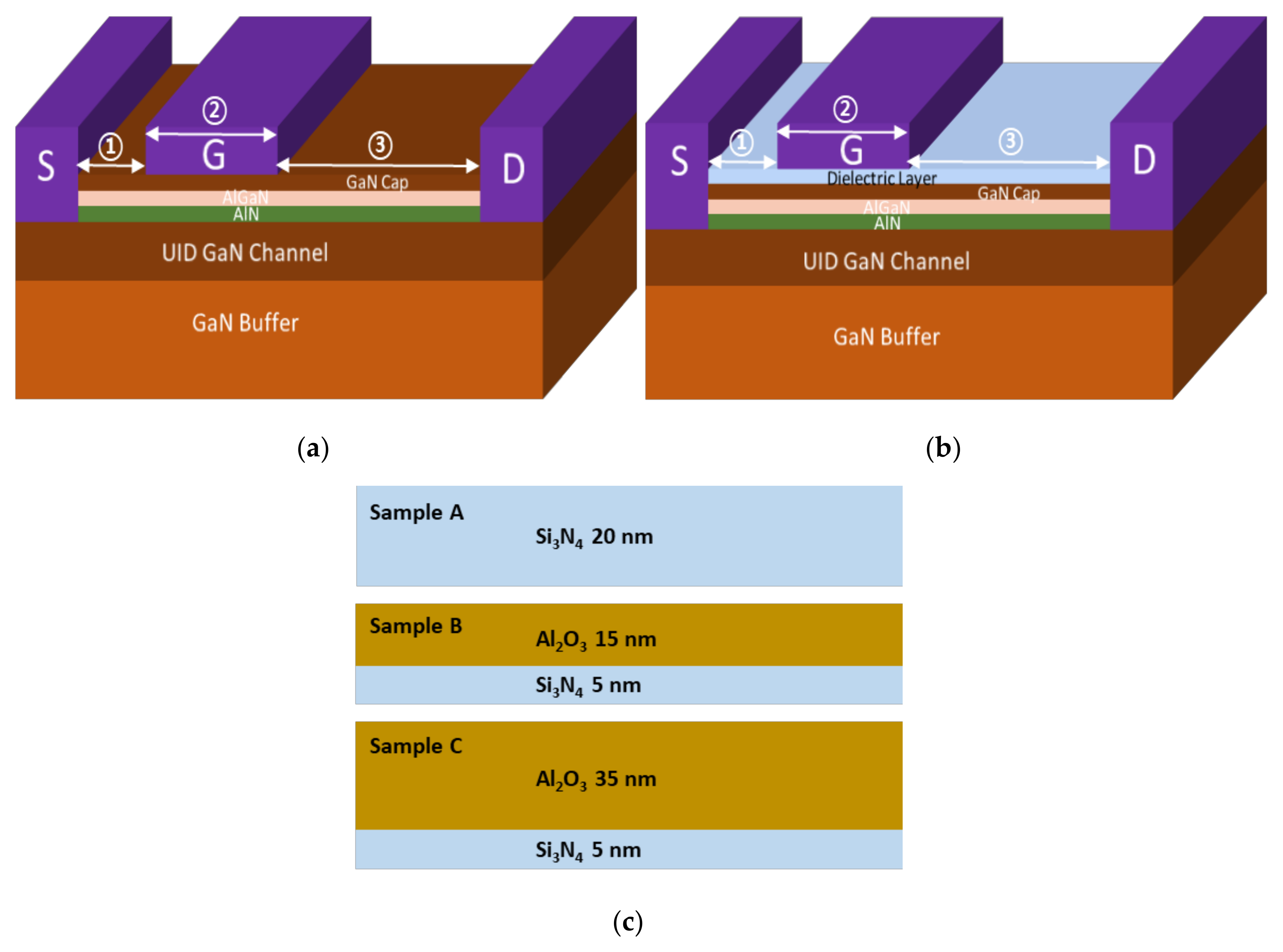
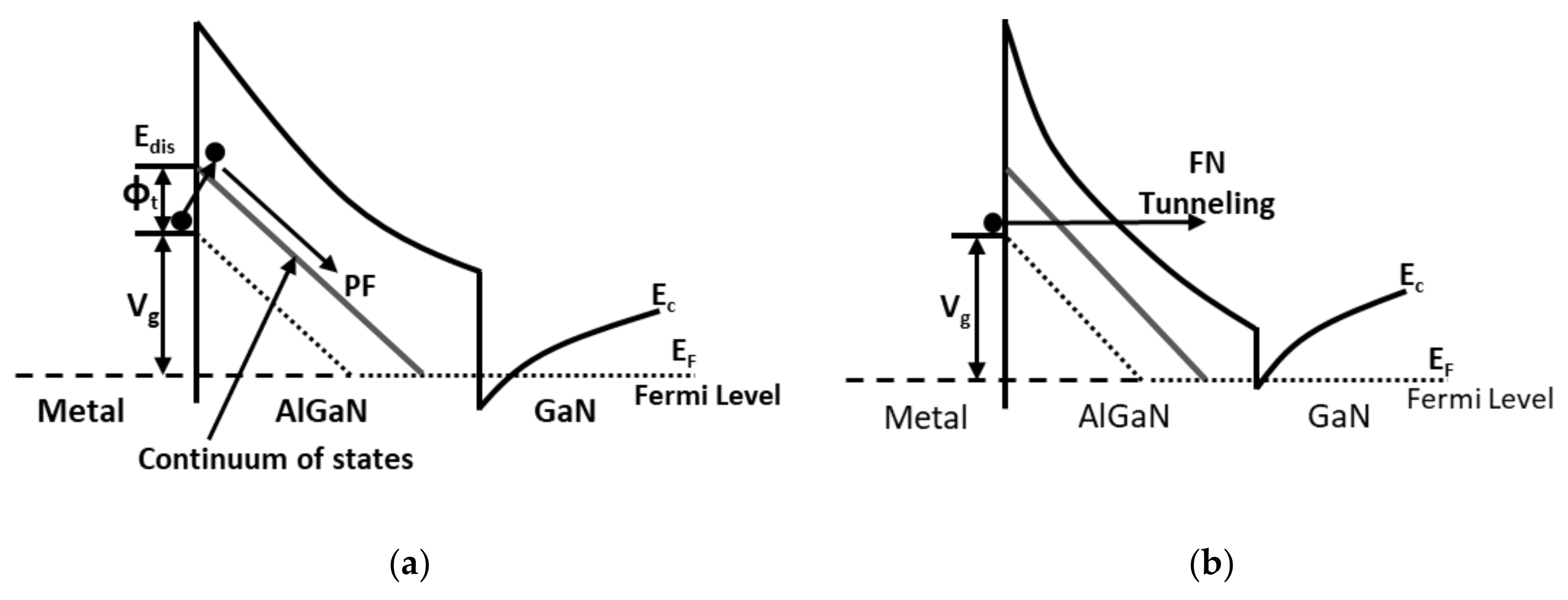
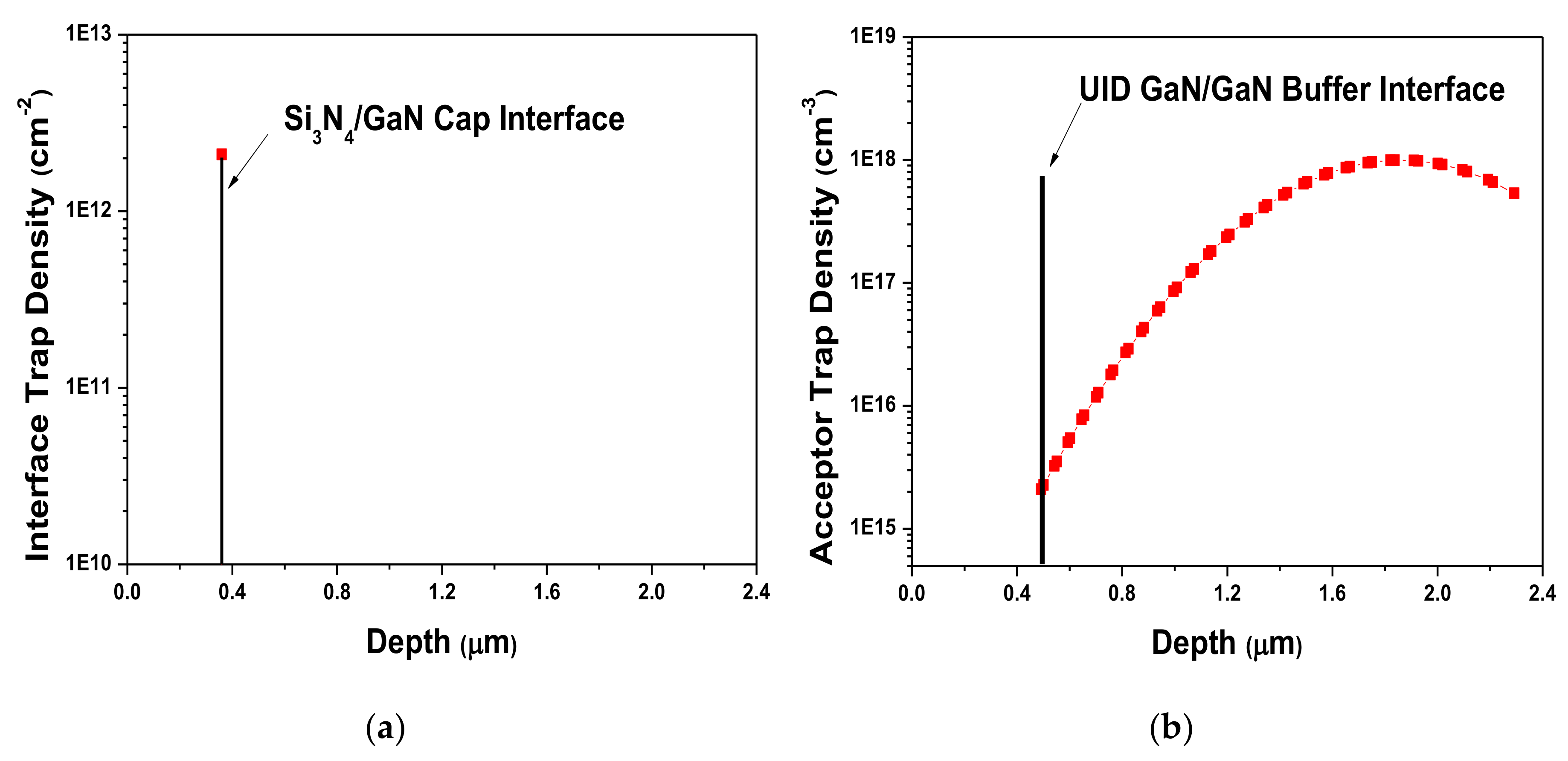
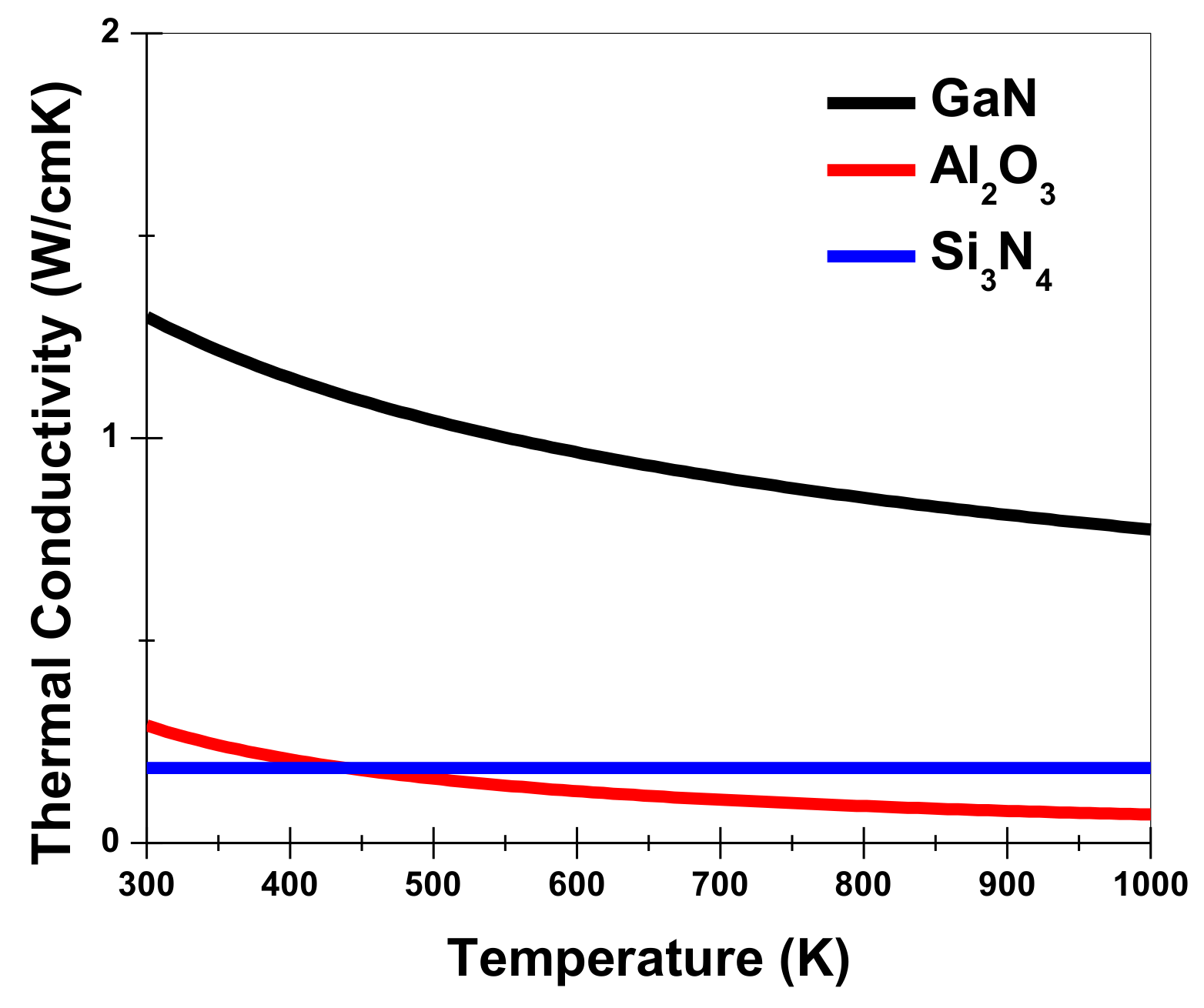
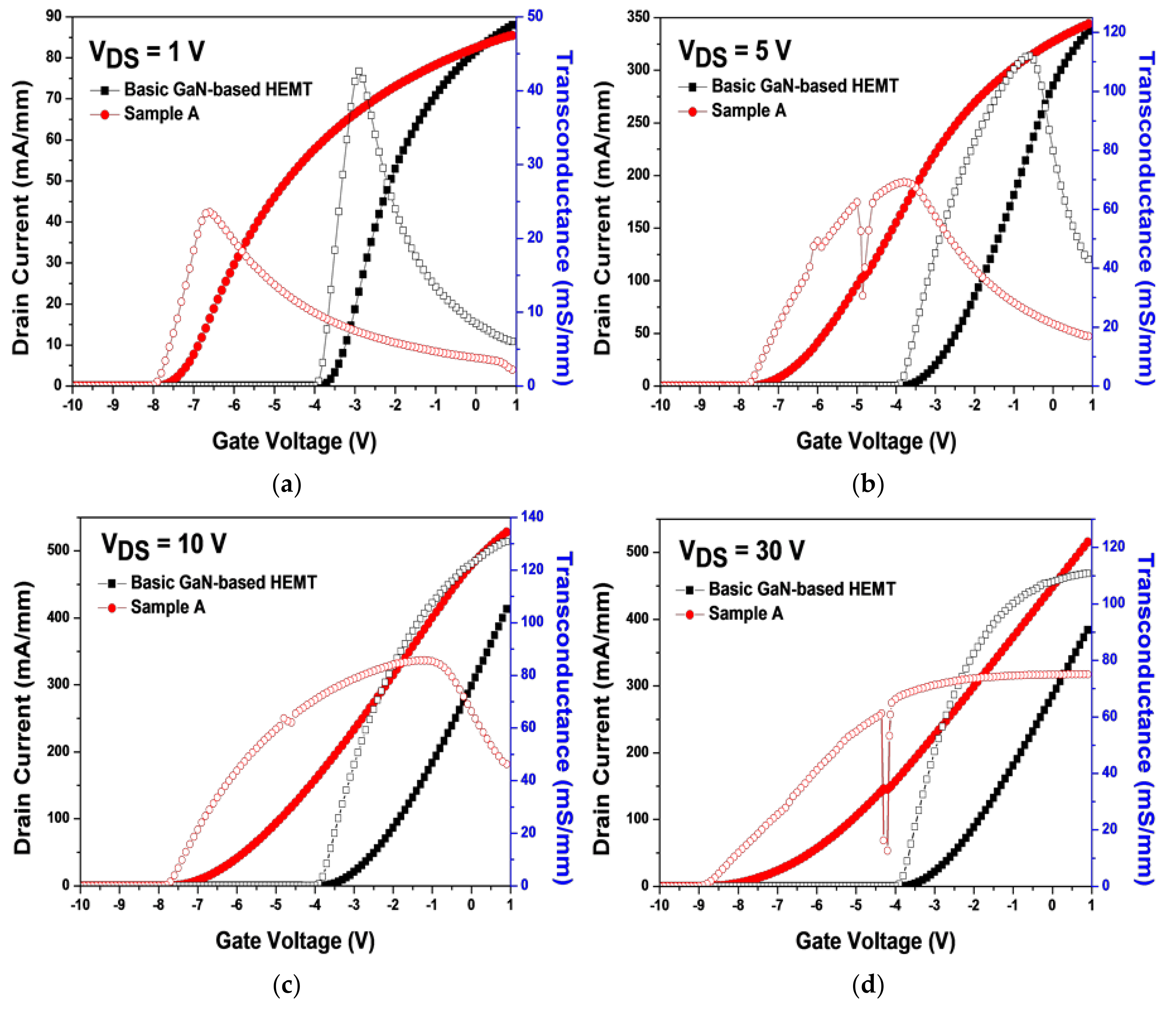
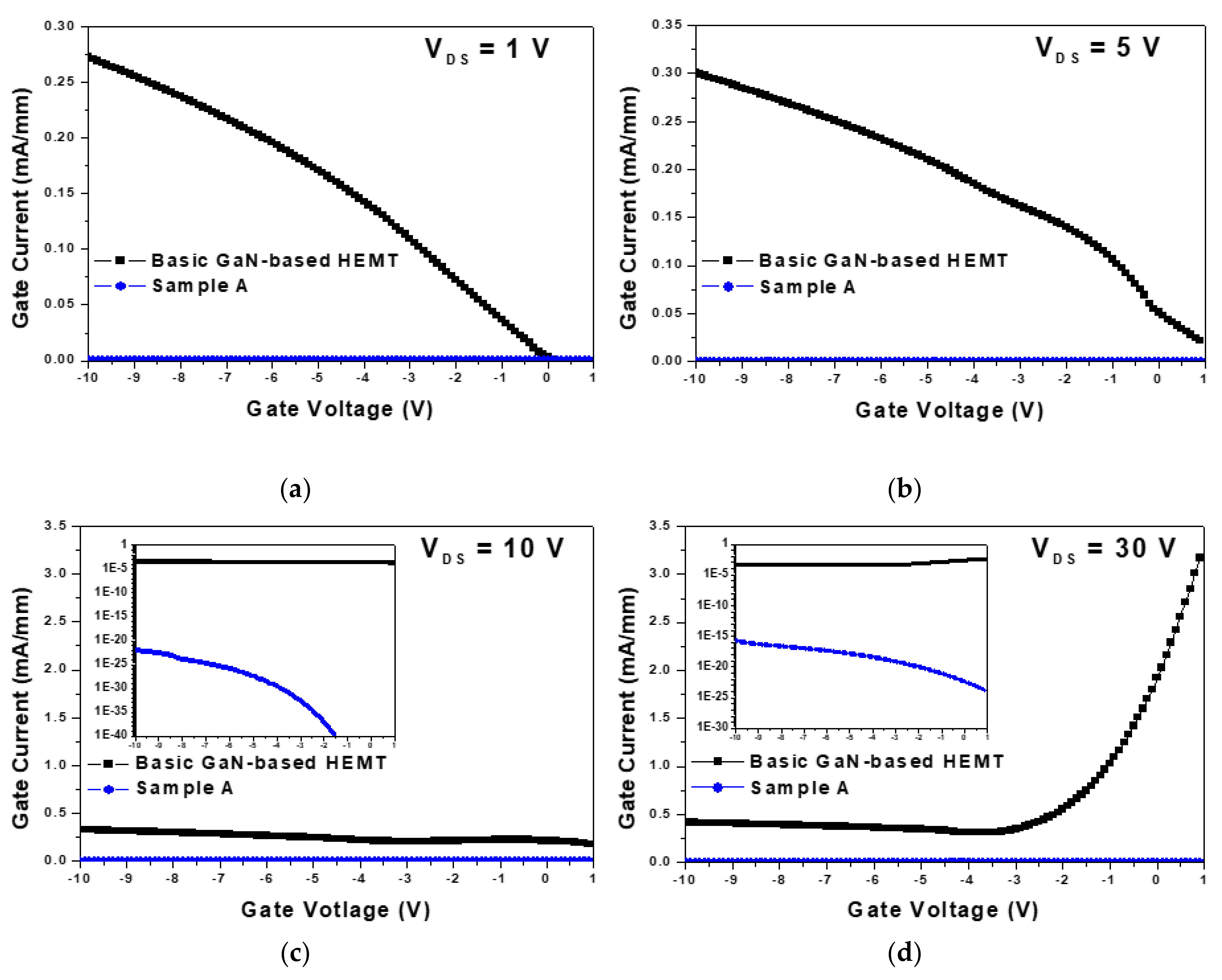
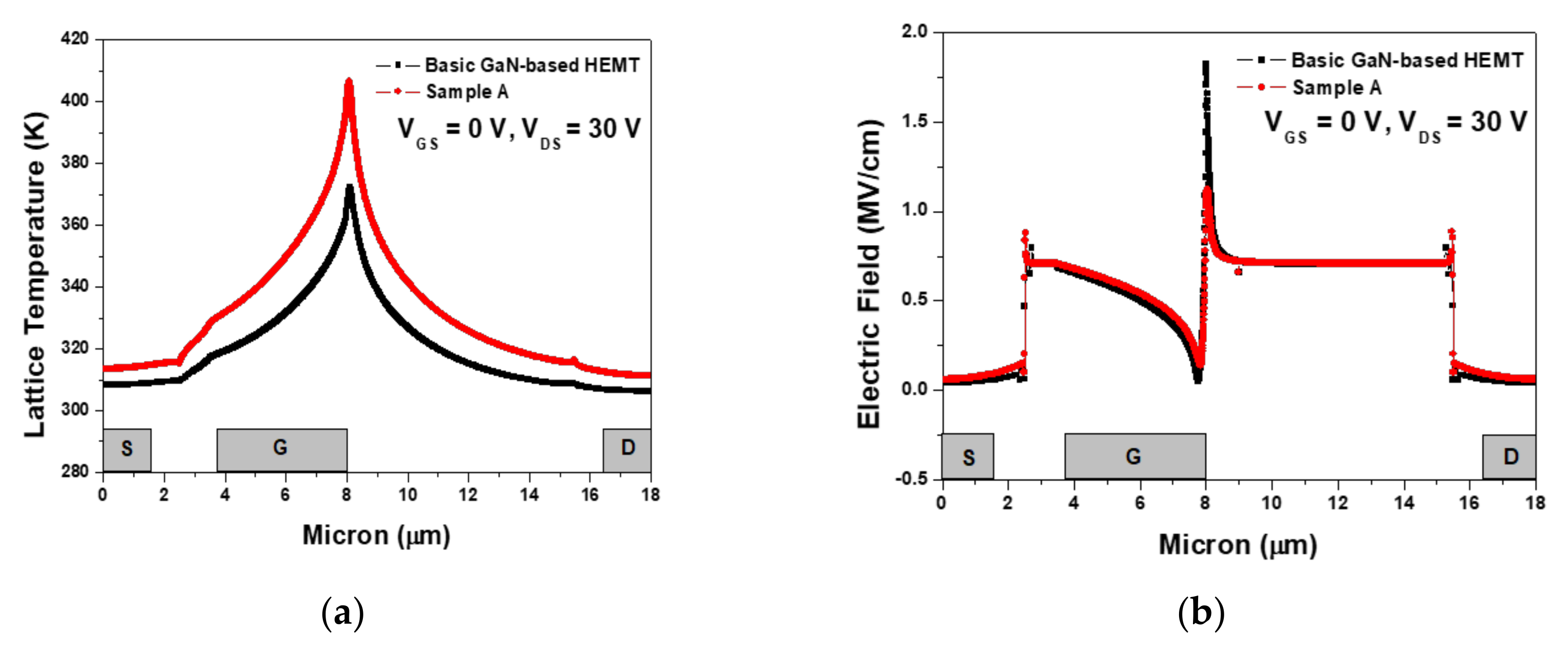
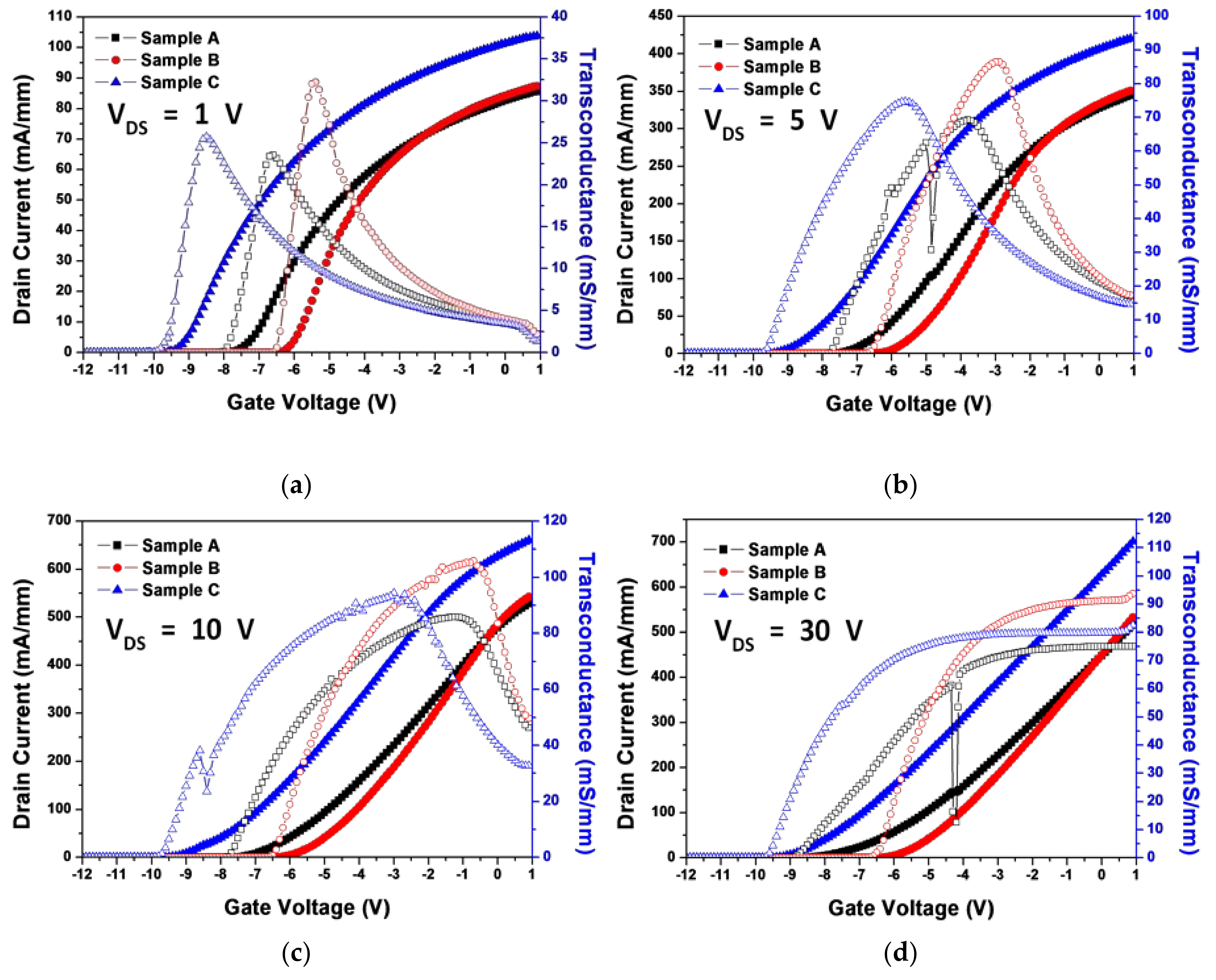

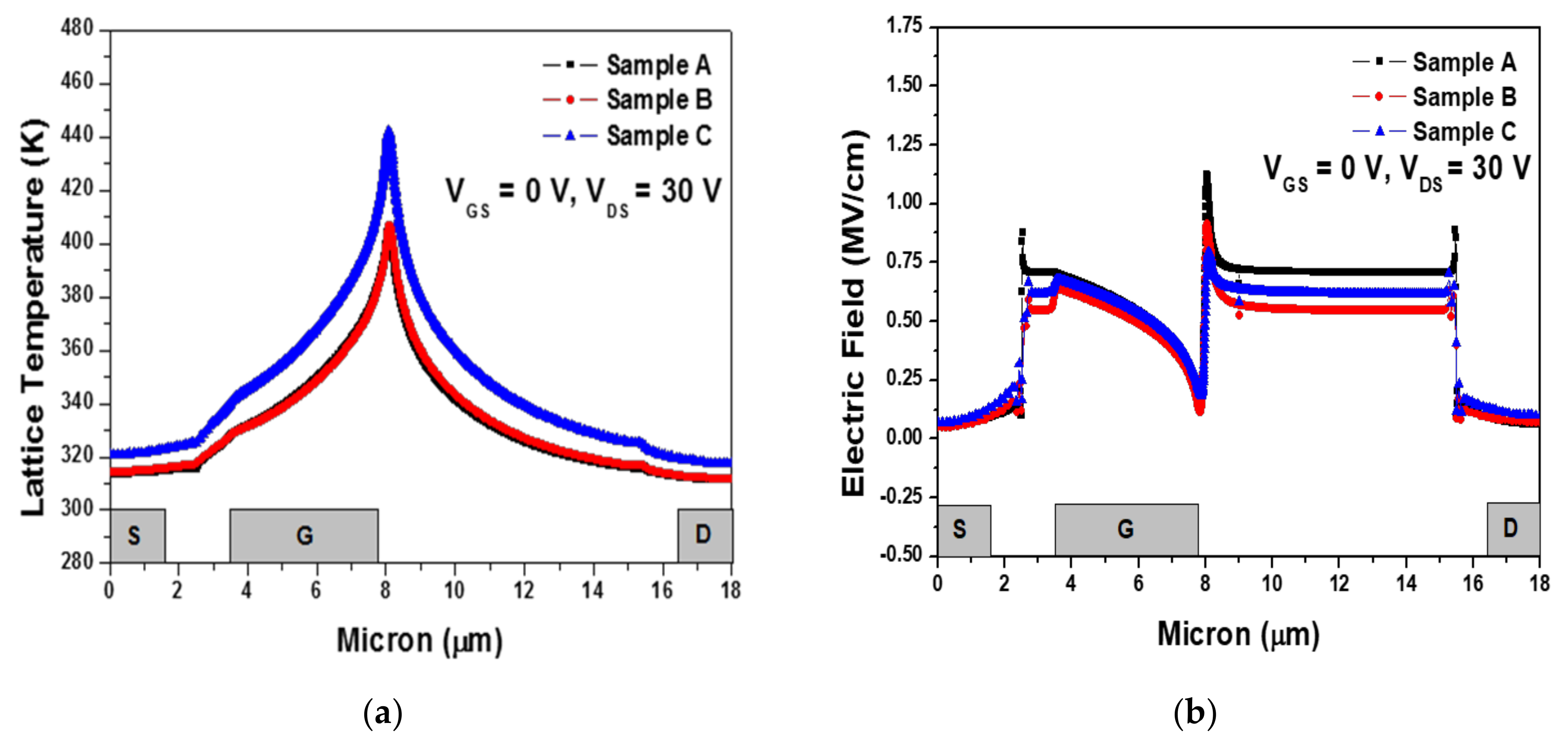
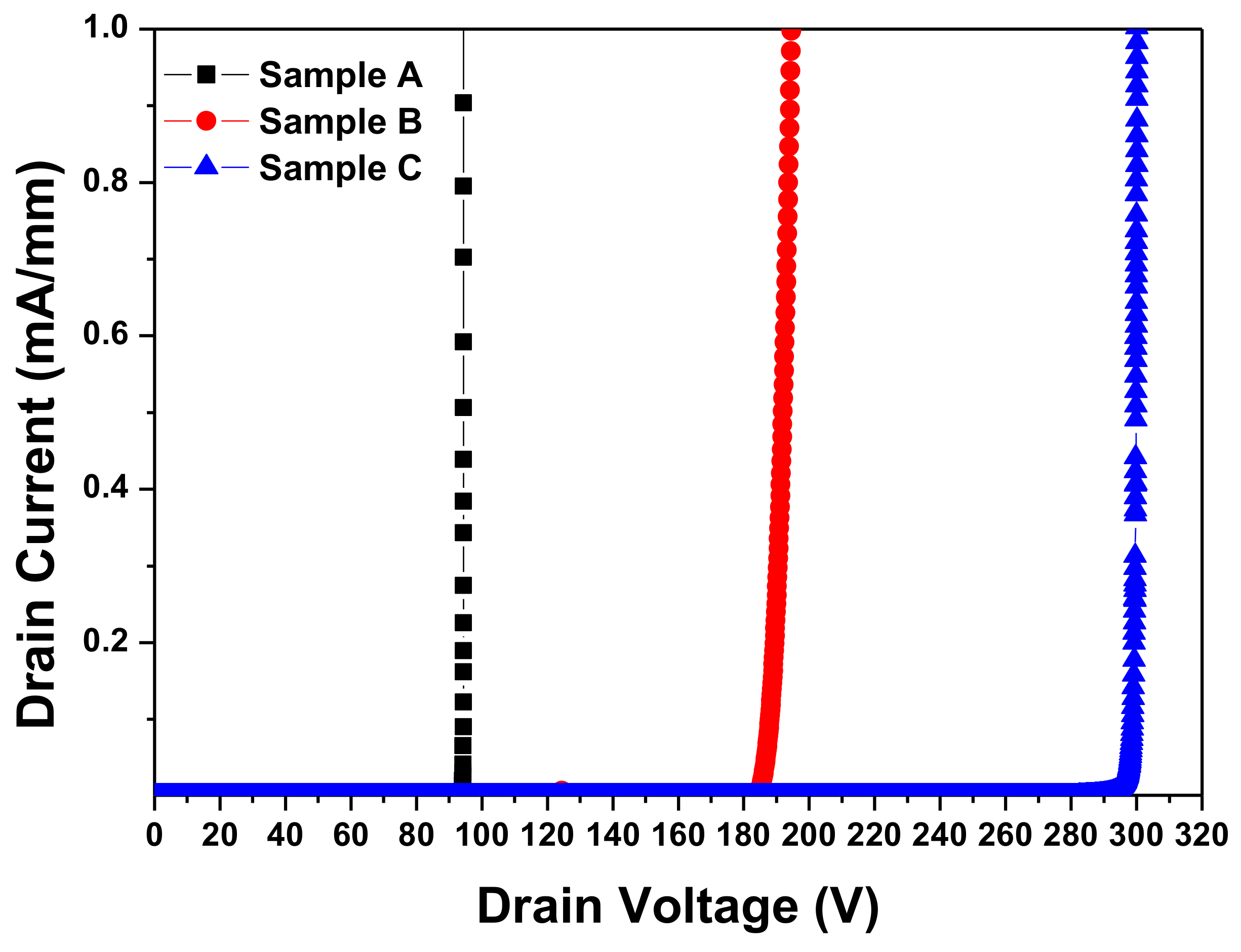
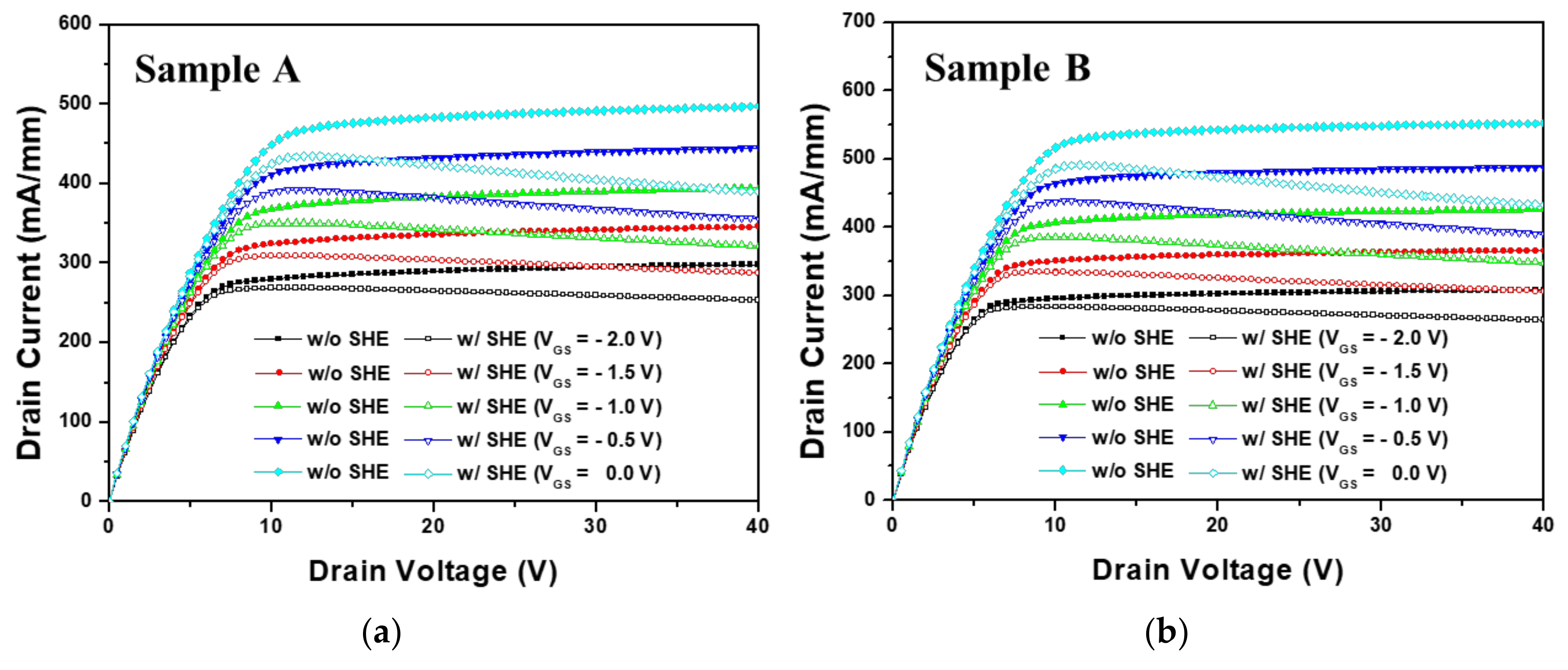
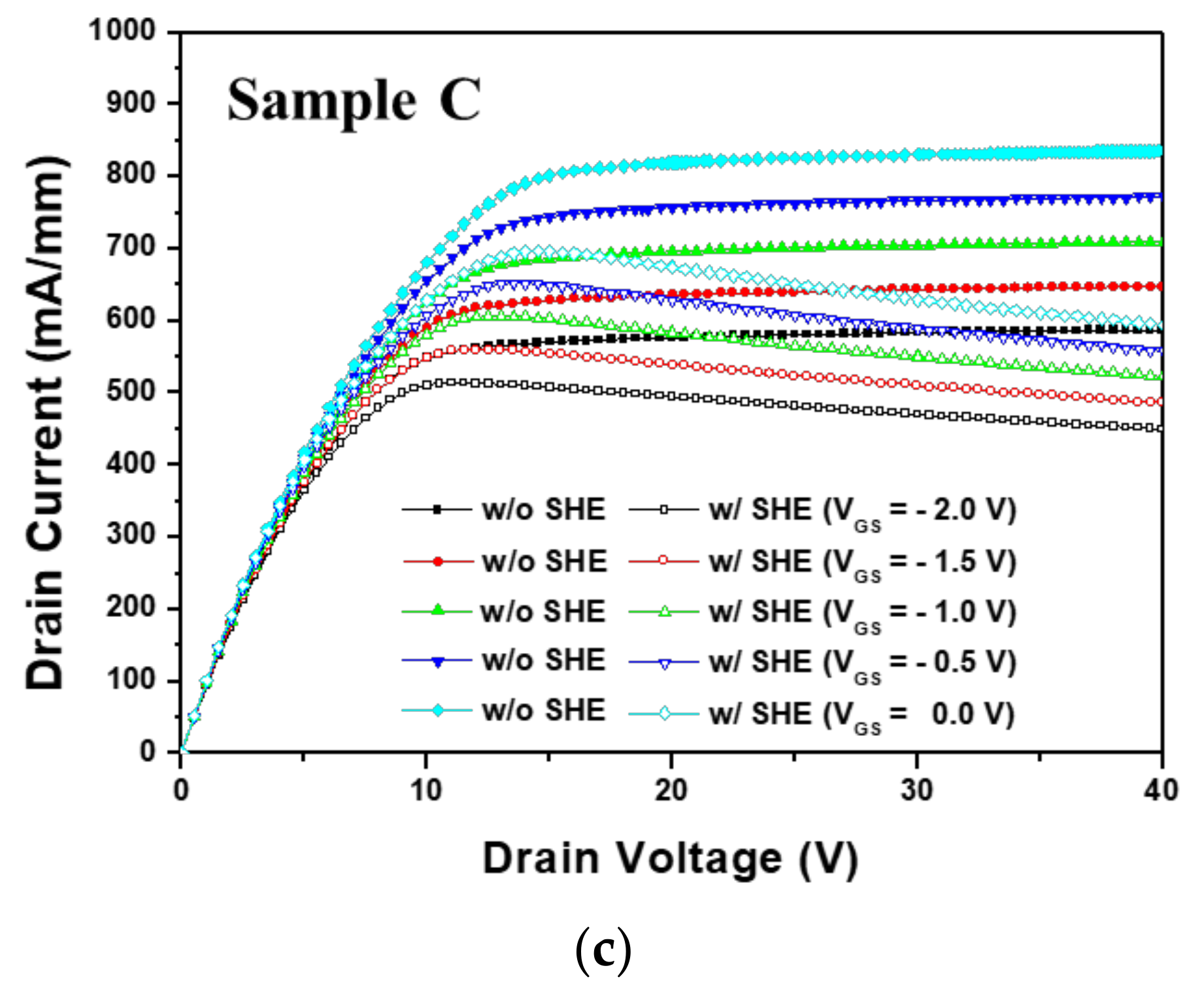
| Parameter | Value |
|---|---|
| ① | 1.0 µm |
| ② | 4.5 µm |
| ③ | 9.5 µm |
| GaN Cap | 2.0 nm |
| AlGaN | 21 nm |
| AlN | 1.0 nm |
| UID GaN Channel | 0.1 µm |
| GaN Buffer | 1.8 µm |
| Parameter | GaN | AlGaN |
|---|---|---|
| Bandgap energy (eV) | 3.39 | 3.89 |
| Electron affinity (eV) | 4 | 3.6 |
| Low field mobility (cm2 V−1 s−1) | 990 | 300 |
| Relative permittivity | 9.5 | 9.38 |
| Thermal conductivity constant (W cm−1 K−1) | 1.3 | 0.4 |
| TC.NPOW | 0.43 | - |
| High field mobility model | GANSAT saturation velocity model | |
| Electron Saturation velocity (cm s-1) | 1.9 × 107 | 1.12 × 107 |
| Type | ΔID (mA/mm) (at VDS = 40 V) | ||||
|---|---|---|---|---|---|
| VGS = −2.0 V | VGS = −1.5 V | VGS = −1.0 V | VGS = −0.5 V | VGS = 0.0 V | |
| A | −45.17 | −58.38 | −73.23 | −89.49 | −107.41 |
| B | −44.49 | −60.10 | −77.99 | −98.01 | −119.92 |
| C | −138.17 | −161.87 | −187.07 | −213.58 | −241.27 |
© 2019 by the authors. Licensee MDPI, Basel, Switzerland. This article is an open access article distributed under the terms and conditions of the Creative Commons Attribution (CC BY) license (http://creativecommons.org/licenses/by/4.0/).
Share and Cite
Hwang, I.-T.; Jang, K.-W.; Kim, H.-J.; Lee, S.-H.; Lim, J.-W.; Yang, J.-M.; Kwon, H.-S.; Kim, H.-S. Analysis of DC Characteristics in GaN-Based Metal-Insulator-Semiconductor High Electron Mobility Transistor with Variation of Gate Dielectric Layer Composition by Considering Self-Heating Effect. Appl. Sci. 2019, 9, 3610. https://doi.org/10.3390/app9173610
Hwang I-T, Jang K-W, Kim H-J, Lee S-H, Lim J-W, Yang J-M, Kwon H-S, Kim H-S. Analysis of DC Characteristics in GaN-Based Metal-Insulator-Semiconductor High Electron Mobility Transistor with Variation of Gate Dielectric Layer Composition by Considering Self-Heating Effect. Applied Sciences. 2019; 9(17):3610. https://doi.org/10.3390/app9173610
Chicago/Turabian StyleHwang, In-Tae, Kyu-Won Jang, Hyun-Jung Kim, Sang-Heung Lee, Jong-Won Lim, Jin-Mo Yang, Ho-Sang Kwon, and Hyun-Seok Kim. 2019. "Analysis of DC Characteristics in GaN-Based Metal-Insulator-Semiconductor High Electron Mobility Transistor with Variation of Gate Dielectric Layer Composition by Considering Self-Heating Effect" Applied Sciences 9, no. 17: 3610. https://doi.org/10.3390/app9173610
APA StyleHwang, I.-T., Jang, K.-W., Kim, H.-J., Lee, S.-H., Lim, J.-W., Yang, J.-M., Kwon, H.-S., & Kim, H.-S. (2019). Analysis of DC Characteristics in GaN-Based Metal-Insulator-Semiconductor High Electron Mobility Transistor with Variation of Gate Dielectric Layer Composition by Considering Self-Heating Effect. Applied Sciences, 9(17), 3610. https://doi.org/10.3390/app9173610





